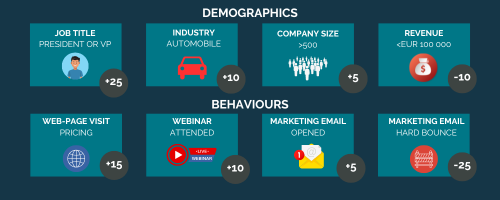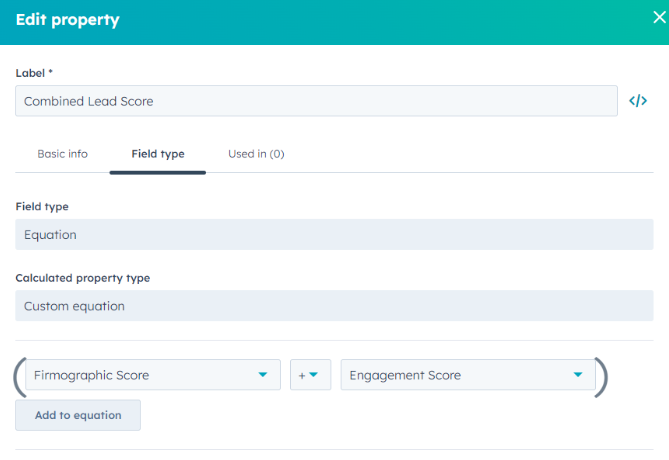What is Lead Scoring?
Lead Scoring involves assigning points to specific behaviours and attributes displayed by leads that match your Ideal Client Profile (ICP). This process is automated, allowing for easy tracking of lead engagement and fits within your CRM. As a result, you can easily identify which contacts and accounts to focus on.
How Does Lead Scoring Work?
Lead scoring is a process used by businesses to determine the level of interest a potential customer has in their product or service. The process assigns a score to each lead based on a set of predetermined criteria, such as demographics, firmographics, and behaviours. The higher the score, the more likely the lead is to be interested in purchasing from the company.
There are two main types of lead scoring categories: Behaviour and Firmographic (or demographic). B2B lead scoring depends on firmographic data just as much as a B2C buying process would. As in B2C scenarios, a B2B organisation should build their score relevant to fit the ideal customer profile (ICP), to ensure resources are focused on closing an ideal customer. All ICPs must be built on real data, not assumptions. Firmographic scoring may include data obtained from third-party sources, such as a lead's job title or company size.
Behavioural lead scoring is all about identifying key behavioural indicators that imply that a prospect is sales-ready.
To create a lead scoring model, businesses must first identify the characteristics of their ideal customer and the behaviours that are most indicative of interest in their product or service. They then assign point values to each criterion, with higher values assigned to those that are most indicative of a high-quality lead.
Lead scoring can be an effective tool for improving sales efficiency and closing rates. By focusing on the most promising leads, businesses can avoid wasting time and resources on leads that are unlikely to convert and instead focus their efforts on those that are most likely to result in a sale.
Examples of Demographic/ Firmographic & Behaviours Scoring:

Lead Scoring Best Practices
Identify Your Contact Criteria
The common criteria you have identified amongst your contacts that best describe your Ideal Client Profile (ICP), client behaviours, and the contact's BANT (budget, authority, need, and timeline). Lead scoring must be structured around the ICP and can only succeed if the ICP is accurate. Determine the ICP and clearly align it with the campaign goals.
The size of your targeted client profile is determined by your own capabilities. A company headcount of over 5000+ could be out of your capabilities, so rather determine the scope of the clients you can service. A client who is geographically outside of your ICP is negatively scored.
Whereby, an ideal client’s business who is actively searching for a business with your services and comes on your radar after they land on your services page and fill in a demo contact form will be highly scored.
Building an Engagement & Firmographic Score
At Maven TM, we build two separate score profiles. The first focused on Firmographic Score and the second focused on Engagement Scoring. The Firmographic score is built on elements such as job title, job role (or seniority level to determine decision-maker status), annual revenue, prospect location and associated company location etc. The engagement score is more straightforward and determined by the activities that you deem important to positive (or negative) buyer behaviours. The most common would-be positive scoring form submissions, however, if a prospect unsubscribed or emails hard bounce, these could be factors to remove the prospect from your efforts.
To calculate a “whole” score, we build a calculated score property, as below.

Advanced Lead Scoring Techniques
What is predictive scoring?
CRM systems like HubSpot utilize predictive machine learning algorithms to determine the probability of a contact becoming a customer within 90 days. The Likelihood to Close and Contact Priority properties analyse, and segment contacts based on this scoring model, with these services being available exclusively to Enterprise HubSpot users.
The Likelihood to Close property is a score representing the percentage probability of a contact becoming a customer within the next 90 days, based on specific contact properties and activities. For example, a contact with a score of 22 has a 22% chance of closing as a customer within 90 days.
The Contact Priority property ranks contacts evenly into tiers, based on their Likelihood to Close scores, with options ranging from Very High to Low, and Closed Won. Contacts are grouped based on a logic where each tier contains 25% of contacts, based on their Likelihood to Close score. As these categories are relative groupings, the score range in each tier may shift over time.
Score Degradation
The technique of score degradation can be employed to monitor stagnant leads. By reducing the score of a lead that has not engaged with your brand for a considerable time, you can identify unproductive leads. For instance, if a lead has stopped opening your company's emails or has downloaded one piece of content but hasn't visited the website again, their score can be lowered. As with negative scoring, score degradation helps to identify unproductive leads allowing your team to focus on warmer leads.
To implement score degradation, you must determine the actions that deserve point deductions when the lead discontinues them. To start with, you can consider reversing the point system you use for implicit scoring. For example, if a lead gains 10 points for subscribing to your newsletter, they will lose 10 points for unsubscribing. Alternatively, you can consult your marketing team to identify the consistent actions that promising leads perform.
Lead Scoring Helps Focus Efforts
By concentrating exclusively on qualified leads, you save time and avoid the frustration of attempting to reach and convert prospects who are not yet prepared or may never be. However, it is important to note that a lead scoring model requires regular maintenance. If you perceive that your leads are either over or undervalued, examine your customer data to determine whether your model requires adjustments.
Conclusion
Like any other practice, marketing automation, content marketing, and lead scoring require time and effort to refine and optimise for each business. Understanding the factors that motivate customers to buy your product, the aspects that attract them to it, and identifying the most suitable target audience is crucial in determining the effectiveness of your lead-scoring strategy.
If you are looking for a HubSpot Lead Scoring partner, we may be able to help. Get in touch and lets one of our experts talk you through our process.
Read more on our blog: MAVEN TM’S GUIDE TO HUBSPOT LEAD SCORING

.png?width=400&height=100&name=Maven%20TM%20White%20Logo%20Image%20(1).png)
